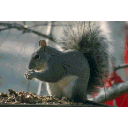
James taking measurements in the field. James Armstrong, M.S., 1997
James Armstrong, M.S., 1997
(Forest Ranger, KY Forest Service)Department of Biology
Murray State University, Murray KY 42071
Nest-site selection and leaf-nest composition of gray squirrels (Sciurus carolinensis) in an area of isolated woods and in continuous woods in western Kentucky.ABSTRACT:
Location and composition of gray squirrel (Sciurus carolinensis) leaf-nests were analyzed in three different forest haitats: Younger (85-92 years) continuous-forest habitat (3 sites, 2 ha each), Older (116-125 years) continuous-forest habitat (3 sites, 2 ha each), and an isolated woodlot (106 years) habitat (1 site, 3 ha). The isolated woodlot habitat had significantly higher nest density (12.5 nests/ha) than younger or older continuous-forest habitats (3.3 +/-0.3 SE nests/ha and 3.2 +/- 0.9 SE nests/ha, respectively). The density of gray squirrels in the isolated woodlot (13.2 squirrels/ha) was also significantly greater than the density of squirrels in the younger and older continous-forests (1.8 +/- 1.0 SE and 1.9 +/- 0.6 SE squirrles/ha, respectively). Gray squirrels consistently chose medium dbh (20- 50 cm) oaks for leaf-nest placement in each habitat studied. Locatoin of nest placement within the host-tree was consistent among habitats. The sizes and composition of leaf-nests did not differ among habitats although the leaf-nests in the older continuous-forests had the greatest dry masses. Management methods for gray squirrels can be more effective with knowledge of the nesting sites preferred by gray squirrels. Sizes and species of nest-trees preferred by gray squirrels should be taken into account when managing for this game species. Timber harvesters should also be aware of the possible destruction of preferred nest-sites when cutting medium to large dbh trees.
Constructed by Brandon Kellie on 6/25/01.
